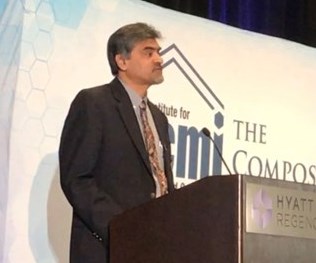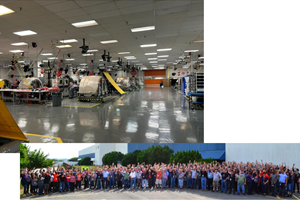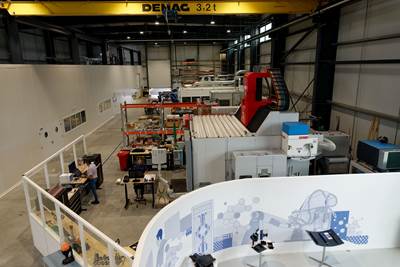Developing new solutions for noise, vibration and harshness
Several recent IACMI partner projects focus on technology innovation related to challenges in noise, vibration and harshness (NVH) in vehicle design.

Uday Vaidya, Chief Technology Officer at IACMI
IACMI — The Composites Institute (Knoxville, Tenn., U.S.) and its project partners have been making significant progress over the past five years, following IACMI’s technology roadmap, in areas already discussed in previous columns this year, such as efforts to reduce the embodied energy of composites, improvements to composites’ recyclability and new solutions for multimaterial joining. Another focus for IACMI projects is reduction of noise, vibration and harshness (NVH) in automotive applications.
Despite enabling energy savings and emissions reductions from lower fuel levels, automotive lightweighting can contribute to unfavorable NVH in vehicle operation.
NVH is most commonly managed through absorption of acoustic energy by physical structures. The comparison of effectiveness of energy absorption between materials is determined by complex relations between physical and design factors, such as mechanical properties, density, intrinsic structure, as well as component geometry, connections and loading. Vehicle mass reduction can be a zero-sum game for automakers in cases where a light material is directly substituted in an existing design, but additional mass is required to meet NVH requirements. Addressing NVH early in the design for a new material can help realize a positive impact on weight, cost and energy.
With respect to IACMI’s goals, NVH challenges directly impact the overall cost of deploying carbon fiber-reinforced polymers (CFRP). While NVH challenges are embodied in passenger sound and ride quality in automotive applications, acoustic energy can also negatively impact rotor rotation speeds in wind turbine applications. Managing NVH costs is easiest if addressed early in product and process design using predictive modeling tools and integrated design approaches.
Considering all aspects of advanced composites integration is important for implementation into the automotive market.
IACMI and its members have identified a range of topical focus areas important for achieving IACMI’s technical goals while also addressing NVH challenges:
- Novel fabrication techniques and advanced lay-up methods can enable highly tailored structures and fiber orientations that improve NVH quality in composites.
- Comprehensive simulation tools and software suites can help address NVH challenges throughout the composite lifecycle — from design, to validation, initial manufacture, use through end-of-life (EOL), recycling and reuse.
- Dynamic material and structural characterization methods improve the accuracy of predictive modeling tools to better control NVH performance costs during early design stages.
- Systems-level design and process modeling approaches permit greater control of early-stage NVH performance through concurrent simulation-based experimental design of materials, components and structures, and their respective manufacturing processes.
- Multimaterial design methods and joining technologies can simultaneously permit the selective integration of new high-performance composites while helping to solve core NVH issues.
- Unique fiber architectures, additively manufactured structural cores, and embedded sensor technologies can help solve NVH issues for automotive and wind turbine applications.
To help guide industry-led technology demonstration projects toward achievable NVH solutions, IACMI and its members co-developed a strategy with the following objectives:
- Align NVH project proposals with industry needs. Industry stakeholders recognize that increased NVH performance helps to boost the adoption and market pull for advanced composites. IACMI will continue to support project opportunities that propose to solve core NVH challenges and reduce downstream change-related costs.
- Proactively address NVH in early product and process design to reduce change-related costs. Integrated design approaches that combine predictive modeling tools with dynamic material/structural characterization approaches can help composites manufacturers proactively control NVH performance costs during the early stages of product design. Demonstrating these cost savings will help promote and accelerate the adoption of composite materials for automotive and wind turbine applications.
- Leverage IACMI’s unique vertically integrated partnerships. NVH challenges are driven by many systems factors, including multi-component composites structures, adhesives, and intermediates, and their respective manufacturing processes. IACMI will continue to facilitate collaborative relationships across the composites manufacturing supply chain to address key NVH needs while delivering lighter composites for automotive and other application markets.
Considering all aspects of advanced composites integration in novel ways – such as how NVH impacts the vehicle and user experience – is important for the implementation of composites into the automotive market. Through better understanding the factors that impact NVH, IACMI can lead industry research to solve problems and continue to drive lightweighting of the automotive sector.
Related Content
The next-generation single-aisle: Implications for the composites industry
While the world continues to wait for new single-aisle program announcements from Airbus and Boeing, it’s clear composites will play a role in their fabrication. But in what ways, and what capacity?
Read MoreHow AI is improving composites operations and factory sustainability
Workforce pain points and various logistical challenges are putting operations resilience and flexibility to the test, but Industry 4.0 advancements could be the key to composites manufacturers’ transformation.
Read MoreReducing accidental separator inclusion in prepreg layup
ST Engineering MRAS discusses the importance of addressing human factors to reduce separator inclusion in bonded structures.
Read MoreThe potential of rCF in fiber-reinforced concrete
A look at how emerging technologies for FRP concrete provide alternatives to traditionally used steel and glass fibers that are more cost-effective and address the sustainability challenge.
Read MoreRead Next
Plant tour: Daher Shap’in TechCenter and composites production plant, Saint-Aignan-de-Grandlieu, France
Co-located R&D and production advance OOA thermosets, thermoplastics, welding, recycling and digital technologies for faster processing and certification of lighter, more sustainable composites.
Read MoreComposites end markets: New space (2025)
Composite materials — with their unmatched strength-to-weight ratio, durability in extreme environments and design versatility — are at the heart of innovations in satellites, propulsion systems and lunar exploration vehicles, propelling the space economy toward a $1.8 trillion future.
Read MoreAssembling the Multifunctional Fuselage Demonstrator: The final welds
Building the all-thermoplastic composite fuselage demonstrator comes to an end with continuous ultrasonic welding of the RH longitudinal fuselage joint and resistance welding for coupling of the fuselage frames across the upper and lower halves.
Read More





















